(d) Additionally Router purchased 60% of the ordinary shares of a radio station, Playtime, a public limited company,on 31 May 2007. The remaining 40% of the ordinary shares are owned by a competitor company who owns asubstantial number of warrants issued
题目
(d) Additionally Router purchased 60% of the ordinary shares of a radio station, Playtime, a public limited company,
on 31 May 2007. The remaining 40% of the ordinary shares are owned by a competitor company who owns a
substantial number of warrants issued by Playtime which are currently exercisable. If these warrants are
exercised, they will result in Router only owning 35% of the voting shares of Playtime. (4 marks)
Required:
Discuss how the above items should be dealt with in the group financial statements of Router for the year ended
31 May 2007.
相似考题
更多“(d) Additionally Router purchased 60% of the ordinary shares of a radio station, Playtime, a public limited company,on 31 May 2007. The remaining 40% of the ordinary shares are owned by a competitor company who owns asubstantial number of warrants issued ”相关问题
-
第1题:
(b) On 31 May 2007, Leigh purchased property, plant and equipment for $4 million. The supplier has agreed to
accept payment for the property, plant and equipment either in cash or in shares. The supplier can either choose
1·5 million shares of the company to be issued in six months time or to receive a cash payment in three months
time equivalent to the market value of 1·3 million shares. It is estimated that the share price will be $3·50 in
three months time and $4 in six months time.
Additionally, at 31 May 2007, one of the directors recently appointed to the board has been granted the right to
choose either 50,000 shares of Leigh or receive a cash payment equal to the current value of 40,000 shares at
the settlement date. This right has been granted because of the performance of the director during the year and
is unconditional at 31 May 2007. The settlement date is 1 July 2008 and the company estimates the fair value
of the share alternative is $2·50 per share at 31 May 2007. The share price of Leigh at 31 May 2007 is $3 per
share, and if the director chooses the share alternative, they must be kept for a period of four years. (9 marks)
Required:
Discuss with suitable computations how the above share based transactions should be accounted for in the
financial statements of Leigh for the year ended 31 May 2007.
正确答案:(b) Transactions that allow choice of settlement are accounted for as cash-settled to the extent that the entity has incurred a
liability (IFRS2 para 34). The share based transaction is treated as the issuance of a compound financial instrument. IFRS2
applies similar measurement principles to determine the value of the constituent parts of a compound instrument as that
required by IAS32 ‘Financial Instruments: Disclosure and Presentation’. The purchase of the property, plant and equipment
(PPE) and the grant to the director, both fall under this section of IFRS2 as the supplier and the director have a choice of
settlement. The fair value of the goods can be measured directly as regards the purchase of the PPE and therefore this fact
determines that the transaction is treated in a certain way. In the case of the director, the fair value of the service rendered
will be determined by the fair value of the equity instruments given and IFRS2 says that this type of share based transaction
should be dealt with in a certain way. Under IFRS2, if the fair value of the goods or services received can be measured directly
and easily then the equity element is determined by taking the fair value of the goods or services less the fair value of the
debt element of this instrument. The debt element is essentially the cash payment that will occur. If the fair value of the goods
or services is measured by reference to the fair value of the equity instruments given then the whole of the compound
instrument should be fair valued. The equity element becomes the difference between the fair value of the equity instruments
granted less the fair value of the debt component. It should take into account the fact that the counterparty must forfeit its
right to receive cash in order to receive the equity instrument.
When Leigh received the property, plant and equipment it should have recorded a liability of $4 million and an increase in
equity of $0·55 million being the difference between the value of the property, plant and equipment and the fair value of theliability. The fair value of the liability is the cash payment of $3·50 x 1·3 million shares, i.e. $4·55 million.
The accounting entry would be:
-
第2题:
(c) At 1 June 2006, Router held a 25% shareholding in a film distribution company, Wireless, a public limited
company. On 1 January 2007, Router sold a 15% holding in Wireless thus reducing its investment to a 10%
holding. Router no longer exercises significant influence over Wireless. Before the sale of the shares the net asset
value of Wireless on 1 January 2007 was $200 million and goodwill relating to the acquisition of Wireless was
$5 million. Router received $40 million for its sale of the 15% holding in Wireless. At 1 January 2007, the fair
value of the remaining investment in Wireless was $23 million and at 31 May 2007 the fair value was
$26 million. (6 marks)
Required:
Discuss how the above items should be dealt with in the group financial statements of Router for the year ended
31 May 2007.Required:
Discuss how the above items should be dealt with in the group financial statements of Router for the year ended
31 May 2007.
正确答案:
(c) The investment in Wireless is currently accounted for using the equity method of accounting under IAS28 ‘Investments in
Associates’. On the sale of a 15% holding, the investment in Wireless will be accounted for in accordance with IAS39. Router
should recognise a gain on the sale of the holding in Wireless of $7 million (Working 1). The gain comprises the following:
(i) the difference between the sale proceeds and the proportion of the net assets sold and
(ii) the goodwill disposed of.
The total gain is shown in the income statement.
The remaining 10 per cent investment will be classified as an ‘available for sale’ financial asset or at ‘fair value through profit
or loss’ financial asset. Changes in fair value for these categories are reported in equity or in the income statement respectively.
At 1 January 2007, the investment will be recorded at fair value and a gain of $1 million $(23 – 22) recorded. At 31 May
2007 a further gain of $(26 – 23) million, i.e. $3 million will be recorded. In order for the investment to be categorised as
at fair value through profit or loss, certain conditions have to be fulfilled. An entity may use this designation when doing so
results in more relevant information by eliminating or significantly reducing a measurement or recognition inconsistency (an
‘accounting mismatch’) or where a group of financial assets and/or financial liabilities is managed and its performance is
evaluated on a fair value basis, in accordance with a documented risk management or investment strategy, and information
about the assets and/ or liabilities is provided internally to the entity’s key management personnel.
-
第3题:
6 Alasdair, aged 42, is single. He is considering investing in property, as he has heard that this represents a good
investment. In order to raise the funds to buy the property, he wants to extract cash from his personal company, Beezer
Limited, whose year end is 31 December.
Beezer Limited was formed on 1 May 1998 with £1,000 of capital issued as 1,000 £1 ordinary shares, and traded
until 1 January 2005 when Alasdair sold the trade and related assets. The company’s only asset is cash of
£120,000. Alasdair wants to extract this cash from the company with the minimum amount of tax payable. He is
considering either, paying himself a dividend of £120,000, on 31 March 2006, after which the company would have
no assets and be wound up or, leaving the cash in the company and then liquidating the company. Costs of liquidation
of £5,000 would then be incurred.
Since Beezer Limited ceased trading, Alasdair has been taken on as a partner at a marketing firm, Gallus & Co. He
estimates his profit share for the year of assessment 2005/06 will be £30,000. He has not made any capital disposals
in the current tax year.
Alasdair wishes to reinvest the cash extracted from Beezer Limited in property but is not sure whether he should invest
directly in residential or commercial property, or do so via some form. of collective investment. He is aware that Gallus
& Co are looking to rent a new warehouse which could be bought for £200,000. Alasdair thinks that he may be able
to buy the warehouse himself and lease it to his firm, but only if he can borrow the additional money to buy the
property.
Alasdair has a 25% shareholding in another company, Glaikit Limited, whose year end is 31 March. The remaining
shares in this company are held by his friend, Gill. Alasdair is considering borrowing £15,000 from Glaikit Limited
on 1 January 2006. He does not intend to pay any interest on the loan, which is likely to be written off some time
in 2007. Alasdair does not have any connection with Glaikit Limited other than his shareholding.
Required:
(a) Advise Alasdair whether or not a dividend payment will result in a higher after-tax cash sum than the
liquidation of Beezer Limited. Assume that either the dividend would be paid on 31 March 2006 or the
liquidation would take place on 31 March 2006. (9 marks)
Assume that Beezer Limited has always paid corporation tax at or above the small companies rate of 19%
and that the tax rates and allowances for 2004/05 apply throughout this part.
正确答案: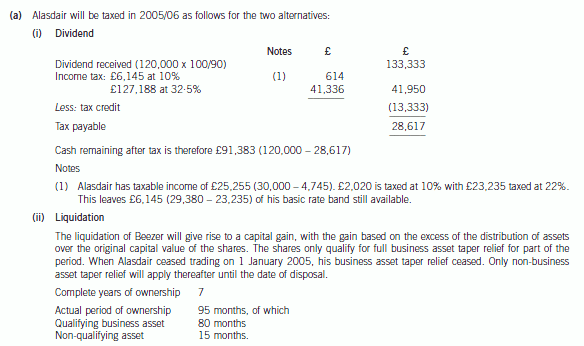
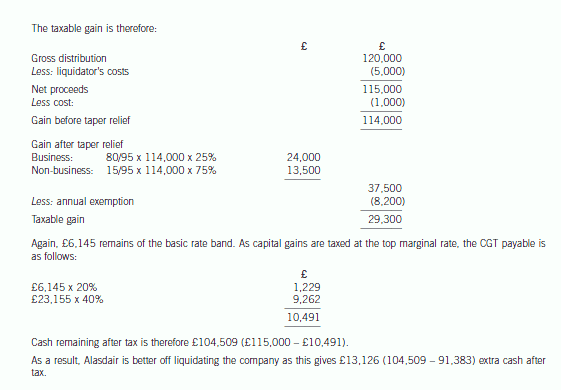
-
第4题:
2 Benny Korere has been employed as the sales director of Golden Tan plc since 1994. He earns an annual salary of
£32,000 and is provided with a petrol-driven company car which has a CO2 emission rate of 187g/km and had a
list price when new of £22,360. In August 2003, when he was first provided with the car, Benny paid the company
£6,100 towards the capital cost of the car. Golden Tan plc does not pay for any of Benny’s private petrol and he is
also required to pay his employer £18 per month as a condition of being able to use the car for private purposes.
On 1 December 2006 Golden Tan plc notified Benny that he would be made redundant on 28 February 2007. On
that day the company will pay him his final month’s salary together with a payment of £8,000 in lieu of the three
remaining months of his six-month notice period in accordance with his employment contract. In addition the
company will pay him £17,500 in return for agreeing not to work for any of its competitors for the six-month period
ending 31 August 2007.
On receiving notification of his redundancy, Benny immediately contacted Joe Egmont, the managing director of
Summer Glow plc, who offered him a senior management position leading the company’s expansion into Eastern
Europe. Summer Glow plc is one of Golden Tan plc’s competitors and one of the most innovative companies in the
industry, although not all of its strategies have been successful.
Benny has agreed to join Summer Glow plc on 1 September 2007 for an annual salary of £39,000. On the day he
joins the company, Summer Glow plc will grant him an option to purchase 10,000 ordinary shares in the company
for £2·20 per share under an unapproved share option scheme. Benny can exercise the option once he has been
employed for six months but must hold the shares for at least a year before he sells them.
The new job will require Benny to spend a considerable amount of time in London. Summer Glow plc has offered
Benny the exclusive use of a flat that the company purchased on 1 June 2003 for £165,000; the flat is currently
rented out. The flat will be made available from 1 September 2007. The company will pay all of the utility bills
relating to the flat as well as furnishing and maintaining it. Summer Glow plc has also suggested that if Benny would
rather live in a more central part of the city, the company could sell the existing flat and buy a more centrally located
one, of the same value, with the proceeds.
On 15 March 2007 Benny intends to sell 5,800 shares in Mahana plc, a quoted company, for £24,608. His
transactions in the company’s shares have been as follows:
£
June 1988 Purchased 8,400 shares 6,744
February 1996 Sale of rights nil paid 610
January 2005 Purchased 1,300 shares 2,281
The sale of rights, nil paid, was not treated as a part disposal of Benny’s holding in Mahana plc.
Benny’s shareholding in Mahana plc represents less than 1% of the company’s issued ordinary share capital. He will
not make any other capital disposals in 2006/07.
In addition to his employment income, Benny receives rental income of £4,000 (net of deductible expenses) each
year. He normally submits his tax return in August but he has not yet prepared his return for 2005/06. He expects
to be very busy in December and January and is planning to prepare his tax return in late February 2007.
Required:
(a) Calculate Benny’s employment income for 2006/07. (4 marks)
正确答案: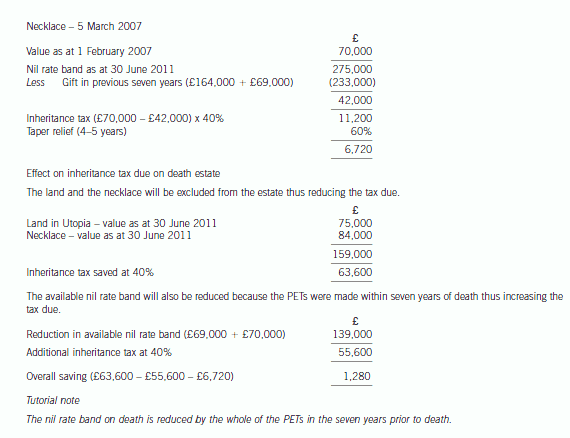
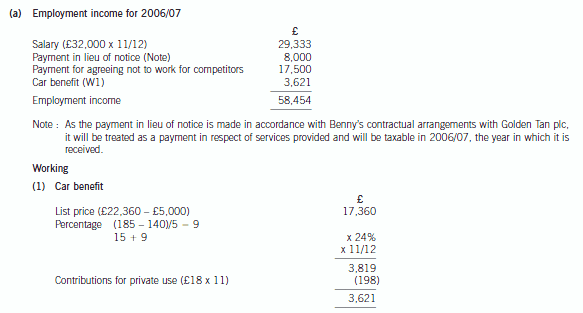
-
第5题:
(c) For commercial reasons, Damian believes that it would be sensible to place a new holding company, Bold plc,
over the existing company, Linden Limited. Bold plc would also be unquoted and would acquire the existing
Linden Limited shares in exchange for the issue of its own shares.
If the new structure is implemented, Bold plc will provide management services to Linden Limited, but the
amount that will be charged for these services is yet to be determined.
Required:
(i) State the capital gains tax (CGT) issues that Damian should be aware of before disposing of his shares
in Linden Limited to Bold plc. Your answer should include details of any conditions that will need to be
satisfied if an immediate charge to tax is to be avoided. (4 marks)
正确答案:
(c) (i) The proposed transaction broadly falls under the ‘paper for paper’ rules. Where this is the case, chargeable gains do not
arise. Instead, the new holding stands in the shoes (and inherits the base cost) of the original holding.
The company issuing the new shares must:
(i) end up with more than 25% of the ordinary share capital or a majority of the voting power of the old company,
OR
(ii) make a general offer to shareholders in the old company with a condition which would give the acquiring company
control of the company if accepted.
The exchange must be for bona fide commercial reasons and not have as its main purpose (or one of its main purposes)
the avoidance of capital gains tax or corporation tax.
The issue of shares by Bold plc satisfies these conditions, thus Damian, as a shareholder of Linden Limited, will not be
taxed on the exchange of shares. -
第6题:
(b) For this part, assume today’s date is 1 May 2010.
Bill and Ben decided not to sell their company, and instead expanded the business themselves. Ben, however,
is now pursuing other interests, and is no longer involved with the day to day activities of Flower Limited. Bill
believes that the company would be better off without Ben as a voting shareholder, and wishes to buy Ben’s
shares. However, Bill does not have sufficient funds to buy the shares himself, and so is wondering if the
company could acquire the shares instead.
The proposed price for Ben’s shares would be £500,000. Both Bill and Ben pay income tax at the higher rate.
Required:
Write a letter to Ben:
(1) stating the income tax (IT) and/or capital gains tax (CGT) implications for Ben if Flower Limited were to
repurchase his 50% holding of ordinary shares, immediately in May 2010; and
(2) advising him of any available planning options that might improve this tax position. Clearly explain any
conditions which must be satisfied and quantify the tax savings which may result.
(13 marks)
Assume that the corporation tax rates for the financial year 2005 and the income tax rates and allowances
for the tax year 2005/06 apply throughout this question.
正确答案:(b) [Ben’s address] [Firm’s address]
Dear Ben [Date]
A company purchase of own shares can be subject to capital gains treatment if certain conditions are satisfied. However, one
of these conditions is that the shares in question must have been held for a minimum period of five years. As at 1 May 2010,
your shares in Flower Limited have only been held for four years and ten months. As a result, the capital gains treatment will
not apply.
In the absence of capital gains treatment, the position on a company repurchase of its own shares is that the payment will
be treated as an income distribution (i.e. a dividend) in the hands of the recipient. The distribution element is calculated as
the proceeds received for the shares less the price paid for them. On the basis that the purchase price is £500,000, then the
element of distribution will be £499,500 (500,000 – 500). This would be taxed as follows: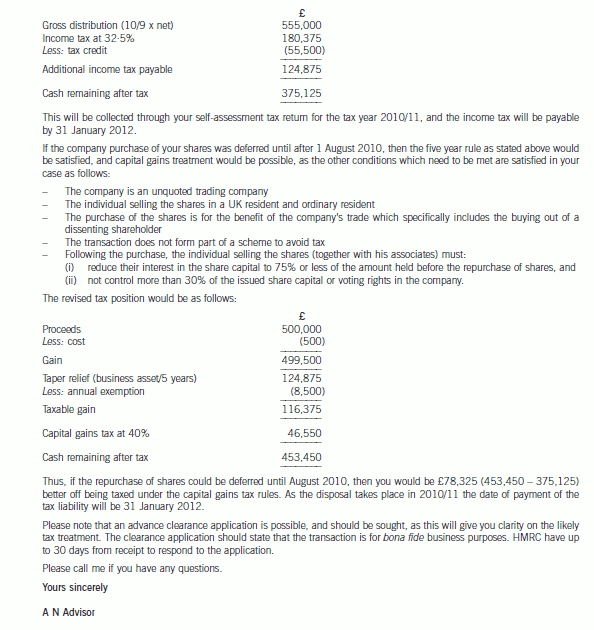
-
第7题:
3 Palm plc recently acquired 100% of the ordinary share capital of Nikau Ltd from Facet Ltd. Palm plc intends to use
Nikau Ltd to develop a new product range, under the name ‘Project Sabal’. Nikau Ltd owns shares in a non-UK
resident company, Date Inc.
The following information has been extracted from client files and from a meeting with the Finance Director of Palm
plc.
Palm plc:
– Has more than 40 wholly owned subsidiaries such that all group companies pay corporation tax at 30%.
– All group companies prepare accounts to 31 March.
– Acquired Nikau Ltd on 1 November 2007 from Facet Ltd, an unrelated company.
Nikau Ltd:
– UK resident company that manufactures domestic electronic appliances for sale in the European Union (EU).
– Large enterprise for the purposes of the enhanced relief available for research and development expenditure.
– Trading losses brought forward as at 1 April 2007 of £195,700.
– Budgeted taxable trading profit of £360,000 for the year ending 31 March 2008 before taking account of ‘Project
Sabal’.
– Dividend income of £38,200 will be received in the year ending 31 March 2008 in respect of the shares in Date
Inc.
‘Project Sabal’:
– Development of a range of electronic appliances, for sale in North America.
– Project Sabal will represent a significant advance in the technology of domestic appliances.
– Nikau Ltd will spend £70,000 on staffing costs and consumables researching and developing the necessary
technology between now and 31 March 2008. Further costs will be incurred in the following year.
– Sales to North America will commence in 2009 and are expected to generate significant profits from that year.
Shares in Date Inc:
– Nikau Ltd owns 35% of the ordinary share capital of Date Inc.
– The shares were purchased from Facet Ltd on 1 June 2003 for their market value of £338,000.
– The sale was a no gain, no loss transfer for the purposes of corporation tax.
– Facet Ltd purchased the shares in Date Inc on 1 March 1994 for £137,000.
Date Inc:
– A controlled foreign company resident in the country of Palladia.
– Annual chargeable profits arising out of property investment activities are approximately £120,000, of which
approximately £115,000 is distributed to its shareholders each year.
The tax system in Palladia:
– No taxes on income or capital profits.
– 4% withholding tax on dividends paid to shareholders resident outside Palladia.
Required:
(a) Prepare detailed explanatory notes, including relevant supporting calculations, on the effect of the following
issues on the amount of corporation tax payable by Nikau Ltd for the year ending 31 March 2008.
(i) The costs of developing ‘Project Sabal’ and the significant commercial changes to the company’s
activities arising out of its implementation. (8 marks)
正确答案:
(a) Nikau Ltd – Effect on corporation tax payable for the year ending 31 March 2008
(i) Project Sabal
Research and development expenditure
The expenditure incurred in respect of research and development will give rise to an enhanced deduction for the
purposes of computing the taxable trading profits of Nikau Ltd. The enhanced deduction is 125% of the qualifying
expenditure as Nikau Ltd is a large enterprise for this purpose.
The expenditure will reduce the profits chargeable to corporation tax of Nikau Ltd by £87,500 (£70,000 x 1·25) and
its corporation tax liability by £26,250 (£87,500 x 30%).
The budgeted expenditure will qualify for the enhanced deduction because it appears to satisfy the following conditions.
– It is likely to qualify as research and development expenditure within generally accepted accounting principles as
it will result in new technical knowledge and the production of a substantially improved device for use in the
industry.
– It exceeds £10,000 in Nikau Ltd’s accounting period.
– It relates to staff costs, consumable items or other qualifying expenditure as opposed to capital items.
– It will result in further trading activities for Nikau Ltd.
Use of brought forward trading losses
The development of products for the North American market is likely to represent a major change in the nature and
conduct of the trade of Nikau Ltd. This is because the company is developing new products and intends to sell them in
a new market. It is a major change as sales to North America are expected to generate significant additional profits.
Because this change will occur within three years of the change in the ownership of Nikau Ltd on 1 November 2007,
any trading losses arising prior to that date cannot be carried forward beyond that date.
Accordingly, the trading losses brought forward may only be offset against £158,958 ((£360,000 – £87,500) x 7/12)
of the company’s trading profits for the year. The remainder of the trading losses £36,742 (£195,700 – £158,958) will
be lost resulting in lost tax relief of £11,023 (£36,742 x 30%).
Tutorial note
The profits for the year ending 31 March 2008 will be apportioned to the periods pre and post 1 November 2007 on
either a time basis or some other basis that is just and reasonable. -
第8题:
3 Spica, one of the director shareholders of Acrux Ltd, has been in dispute with the other shareholders over plans to
expand the company’s activities overseas. In order to resolve the position it has been agreed that Spica will sell her
shares back to the company. Once the purchase of her shares has taken place, the company intends to establish a
number of branches overseas and acquire a shareholding in a number of companies that are resident and trade in
overseas countries.
The following information has been obtained from client files and meetings with the parties involved.
Acrux Ltd:
– An unquoted UK resident company.
– Share capital consists of 50,000 ordinary shares issued at £1·90 per share in July 2000.
– None of the other shareholders has any connection with Spica.
The purchase of own shares:
– The company will purchase all of Spica’s shares for £8 per share.
– The transaction will take place by the end of 2008.
Spica:
– Purchased 8,000 shares in Acrux Ltd for £2 per share on 30 September 2003.
– Has no income in the tax year 2008/09.
– Has chargeable capital gains in the tax year 2008/09 of £3,800.
– Has houses in the UK and the country of Solaris and divides her time between them.
Investment in non-UK resident companies:
– Acrux Ltd will acquire between 15% and 20% of each of the non-UK resident companies.
– The companies will not be controlled foreign companies as the rates of tax in the overseas countries will be
between 23% and 42%.
– There may or may not be a double tax treaty between the UK and the overseas countries in which the companies
are resident. Where there is a treaty, it will be based on the OECD model treaty.
– None of the countries concerned levy withholding tax on dividends paid to UK companies.
– The directors of Acrux Ltd are concerned that the rate of tax suffered on the profits of the overseas companies
will be very high as they will be taxed in both the overseas country and in the UK.
Required:
(a) (i) Prepare detailed calculations to determine the most beneficial tax treatment of the payment Spica will
receive for her shares; (7 marks)
正确答案:
-
第9题:
For a limited company, this will include the money ______ issuing shares, and is known as the share capital.A raise for ;
B raised by ;
C raising at
参考答案:B
-
第10题:
Finally, they return the()to the people who bought shares in the company.
A、 cost
B、 price
C、 profits
参考答案:C
-
第11题:
听力原文:M: Professor Wang, could you tell me the advantage of the preferred shares?
W: Preferred shares have certain rights, such as the preferred right to receive dividends before any ordinary dividends maybe declared.
Q: When do preferred shareholders have right to receive dividends?
(17)
A.Before any ordinary dividends are declared.
B.After any ordinary dividends are declared.
C.Before any ordinary dividends are paid.
D.After any ordinary dividends are paid.
正确答案:A
解析:这段对话谈论的是优先股的优势所在,女士的回答是他们能"receive dividends before any ordinary dividends maybe declared",故A选项正确。 -
第12题:
单选题Finally, they return the to the people who bought shares in the company.()Acost
Bprice
Cprofits
正确答案: C解析: 暂无解析 -
第13题:
4 (a) Router, a public limited company operates in the entertainment industry. It recently agreed with a television
company to make a film which will be broadcast on the television company’s network. The fee agreed for the
film was $5 million with a further $100,000 to be paid every time the film is shown on the television company’s
channels. It is hoped that it will be shown on four occasions. The film was completed at a cost of $4 million and
delivered to the television company on 1 April 2007. The television company paid the fee of $5 million on
30 April 2007 but indicated that the film needed substantial editing before they were prepared to broadcast it,
the costs of which would be deducted from any future payments to Router. The directors of Router wish to
recognise the anticipated future income of $400,000 in the financial statements for the year ended 31 May
2007. (5 marks)
Required:
Discuss how the above items should be dealt with in the group financial statements of Router for the year ended
31 May 2007.
正确答案:
(a) Under IAS18 ‘Revenue’, revenue on a service contract is recognised when the outcome of the transaction can be measured
reliably. For revenue arising from the rendering of services, provided that all of the following criteria are met, revenue should
be recognised by reference to the stage of completion of the transaction at the balance sheet date (the percentage-ofcompletion
method) (IAS18 para 20):
(a) the amount of revenue can be measured reliably;
(b) it is probable that the economic benefits will flow to the seller;
(c) the stage of completion at the balance sheet date can be measured reliably; and
(d) the costs incurred, or to be incurred, in respect of the transaction can be measured reliably.
When the above criteria are not met, revenue arising from the rendering of services should be recognised only to the extent
of the expenses recognised that are recoverable. Because the only revenue which can be measured reliably is the fee for
making the film ($5 million), this should therefore be recognised as revenue in the year to 31 May 2007 and matched against
the cost of the film of $4 million. Only when the television company shows the film should any further amounts of $100,000
be recognised as there is an outstanding ‘performance’ condition in the form. of the editing that needs to take place before the
television company will broadcast the film. The costs of the film should not be carried forward and matched against
anticipated future income unless they can be deemed to be an intangible asset under IAS 38 ‘Intangible Assets’. Additionally,
when assessing revenue to be recognised in future years, the costs of the editing and Router’s liability for these costs should
be assessed.
-
第14题:
2 Graeme, aged 57, is married to Catherine, aged 58. They work as medical consultants, and both are higher rate
taxpayers. Barry, their son, is aged 32. Graeme, Catherine and Barry are all UK resident, ordinarily resident and
domiciled. Graeme has come to you for some tax advice.
Graeme has invested in shares for some time, in particular shares in Thistle Dubh Limited. He informs you of the
following transactions in Thistle Dubh Limited shares:
(i) In December 1986, on the death of his grandmother, he inherited 10,000 £1 ordinary shares in Thistle Dubh
Limited, an unquoted UK trading company providing food supplies for sporting events. The probate value of the
shares was 360p per share.
(ii) In March 1992, he took up a rights issue, buying one share for every two held. The price paid for the rights
shares was £10 per share.
(iii) In October 1999, the company underwent a reorganisation, and the ordinary shares were split into two new
classes of ordinary share – ‘T’ shares and ‘D’ shares, each with differing rights. Graeme received two ‘T’ and three
‘D’ shares for each original Thistle Dubh Limited share held. The market values for the ‘T’ shares and the ‘D’
shares on the date of reorganisation were 135p and 405p per share respectively.
(iv) On 1 May 2005, Graeme sold 12,000 ‘T’ shares. The market values for the ‘T’ shares and the ‘D’ shares on that
day were 300p and 600p per share respectively.
(v) In October 2005, Graeme sold all of his ‘D’ shares for £85,000.
(vi) The current market value of ‘T’ shares is 384p per share. The shares remain unquoted.
Graeme and Catherine have owned a holiday cottage in a remote part of the UK for many years. In recent years, they
have used the property infrequently, as they have taken their holidays abroad and the cottage has been let out as
furnished holiday accommodation.
Graeme and Catherine are now considering selling the UK country cottage and purchasing a holiday villa abroad.
Initially they plan to let this villa out on a furnished basis, but following their anticipated retirement, would expect to
occupy the property for a significant part of the year themselves, possibly moving to live in the villa permanently.
Required:
(a) Calculate the total chargeable gains arising on Graeme’s disposals of ‘T’ and ‘D’ ordinary shares in May and
October 2005 respectively. (7 marks)
正确答案: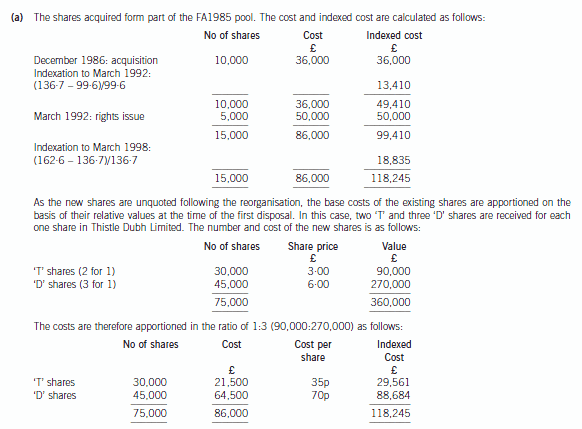
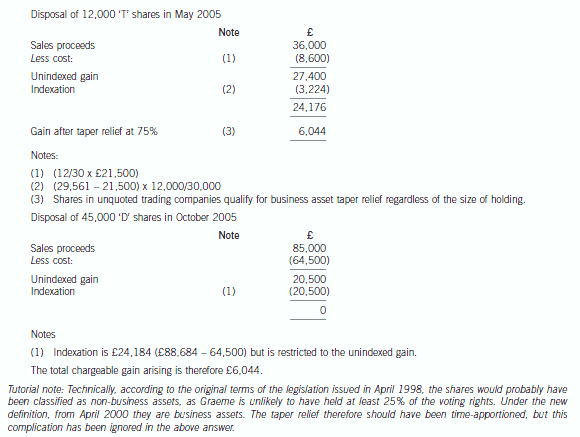
-
第15题:
6 Assume today’s date is 16 April 2005.
Henry, aged 48, is the managing director of Happy Home Ltd, an unquoted UK company specialising in interior
design. He is wealthy in his own right and is married to Helen, who is 45 years old. They have two children – Stephen,
who is 19, and Sally who is 17.
As part of his salary, Henry was given 3,000 shares in Happy Home Ltd with an option to acquire a further 10,000
shares. The options were granted on 15 July 2003, shortly after the company started trading, and were not part of
an approved share option scheme. The free shares were given to Henry on the same day.
The exercise price of the share options was set at the then market value of £1·00 per share. The options are not
capable of being exercised after 10 years from the date of grant. The company has been successful, and the current
value of the shares is now £14·00 per share. Another shareholder has offered to buy the shares at their market value,
so Henry exercised his share options on 14 April 2005 and will sell the shares next week, on 20 April 2005.
With the company growing in size, Henry wishes to recruit high quality staff, but the company lacks the funds to pay
them in cash. Henry believes that giving new employees the chance to buy shares in the company would help recruit
staff, as they could share in the growth in value of Happy Home Ltd. Henry has heard that there is a particular share
scheme that is suitable for small, fast growing companies. He would like to obtain further information on how such
a scheme would work.
Henry has accumulated substantial assets over the years. The family house is owned jointly with Helen, and is worth
£650,000. Henry has a £250,000 mortgage on the house. In addition, Henry has liquid assets worth £340,000
and Helen has shares in quoted companies currently worth £125,000. Henry has no forms of insurance, and believes
he should make sure that his wealth and family are protected. He is keen to find out what options he should be
considering.
Required:
(a) (i) State how the gift of the 3,000 shares in Happy Home Ltd was taxed. (1 mark)
正确答案:
(a) (i) Gift of shares
Shares, which are given free or sold at less than market value, are charged to income tax on the difference between the
market value and the amount paid (if any) for the shares. Henry was given 3,000 shares with a market value of £1 at
the time of gift, so he was assessed to income tax on £3,000, in the tax year 2003/04. -
第16题:
3 Damian is the finance director of Linden Limited, a medium sized, unquoted, UK trading company, with a 31 July
year end. Damian personally owns 10% of the ordinary issued share capital of Linden Limited, for which he paid
£10,000 in June 1998. He estimates that the current market value of Linden Limited is £9 million and that the
company will make taxable profits of £1·4 million in the forthcoming year to 31 July 2007.
(a) Damian believes that Linden Limited should conduct its activities in a socially responsible manner and to this
end has proposed that in future all cars purchased by the company should be low emission vehicles. The sales
director has stated that several of his staff, who are the main recipients of company cars, other than the directors,
are extremely unhappy with this proposal, perceiving it as downgrading their value and status.
The cars currently provided to the sales staff have a list price of £19,600, on which Linden Limited receives a
bulk purchase discount of 6% from the dealer, and a CO2 emission rate of 168 grams/kilometre. The company
pays for up to £400 of accessories, of the salesmen’s own choice to be fitted to the cars and all of the running
costs, including private petrol. The cars are replaced every three years and the ‘old’ cars are sold at auction,
because they are high mileage vehicles.
The low emission cars it is proposed to purchase will have the same list price as the current cars, but the dealer
is only prepared to offer a bulk discount of 5% on these vehicles. Damian does not propose to make any other
changes to Linden Limited’s company car policy or practice.
Required:
(i) Explain the tax consequences of the proposed move to low emission vehicles for both the individual
salesmen and Linden Limited, illustrating your answer by means of relevant calculations of the tax and
national insurance (NIC) savings arising. (9 marks)
正确答案:
(a) (i) Individual salesmen
The taxable benefit is determined by the list price of the vehicle plus the cost of the accessories (£20,000) and the CO2
emission rate. The current vehicles have a CO2 emission rate of 168 grams/kilometre, so the benefit will be calculated
at the rate of 20% ((168 – 140)/5 + 15), resulting in a total annual car and car fuel benefit charge of £6,880 (20,000
x 20% + 14,400 x 20%). The low emission vehicles will be chargeable at the basic percentage rate of 15% resulting
in a total annual car and fuel benefit charge of £5,160 (20,000 x 15% + 14,400 x 15%). The salesmen will thus
make an annual income tax saving at their marginal rate of tax, i.e. £378 (1,720 x 22%) if they are basic rate taxpayers
and £688 (1,720 x 40%) if they are higher rate taxpayers.
Linden Limited
The current vehicles will be classed as ‘expensive’ cars based on the discounted list price plus the cost of the accessories
of £18,824 (19,600 x 94% + 400). The annual writing down allowances will thus be restricted to £3,000 throughout
the period of ownership, but there will be no restriction of the balancing allowance available on disposal. The low
emission vehicles will be eligible for a 100% first year allowance of £19,020 (19,600 x 95% + 400), but there will
also be a balancing charge on disposal equivalent to the sales proceeds. Therefore, the total of the allowances available
over the life of the cars will be effectively the same in both cases. As a single company with taxable profits of
£1·4 million, Linden Limited will pay corporation tax at the small companies marginal rate of 32·75% in the year to
31 July 2007, giving a tax benefit in that year of £5,247 for each low emission car purchased ((19,020 – 3,000) x
32·75%).
The company will also make an annual saving in terms of the Class 1A national insurance contributions payable on the
salesmen’s benefits of £220 ((6,880 – 5,160) x 12·8%). But, as these Class 1A contributions are deductible for
corporation tax, the net saving will only be £205 (220 x (100 – 32·75)%).
As the VAT liability payable on the provision of private fuel is based on engine capacity (not the CO2 emission rate) this
will not necessarily be affected. -
第17题:
4 (a) For this part, assume today’s date is 1 March 2006.
Bill and Ben each own 50% of the ordinary share capital in Flower Limited, an unquoted UK trading company
that makes electronic toys. Flower Limited was incorporated on 1 August 2005 with 1,000 £1 ordinary shares,
and commenced trading on the same day. The business has been successful, and the company has accumulated
a large cash balance of £180,000, which is to be used to purchase a new factory. However, Bill and Ben have
received an offer from a rival company, which they are considering. The offer provides Bill and Ben with two
alternative methods of payment for the purchase of their shares:
(i) £480,000 for the company, inclusive of the £180,000 cash balance.
(ii) £300,000 for the company assuming the cash available for the factory purchase is extracted prior to sale.
Bill and Ben each currently receive a gross salary of £3,750 per month from Flower Limited. Part of the offer
terms is that Bill and Ben would be retained as employees of the company on the same salary.
Neither Bill nor Ben has used any of their capital gains tax annual exemption for the tax year 2005/06.
Required:
(i) Calculate which of the following means of extracting the £180,000 from Flower Limited on 31 March
2006 will result in the highest after tax cash amount for Bill and Ben:
(1) payment of a dividend, or
(2) payment of a salary bonus.
You are not required to consider the corporation tax (CT) implications for Flower Limited in your
answer. (5 marks)
正确答案: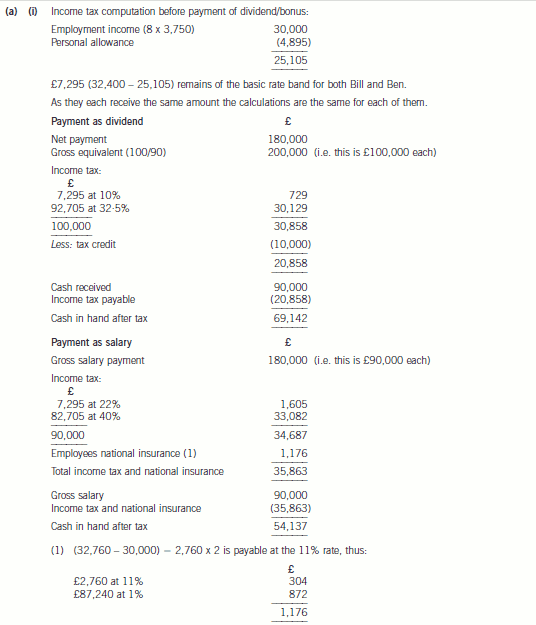
As a result, Bill and Ben would each be better off by £15,005 (69,142 – 54,137). If the cash were extracted by way
of dividend.
Tutorial note: In this answer the employers’ national insurance liability on the salary has been ignored. Credit would be
given to a candidate who recognised this issue. -
第18题:
(b) The directors of Carver Ltd are aware that some of the company’s shareholders want to realise the value in their
shares immediately. Accordingly, instead of investing in the office building or the share portfolio they are
considering two alternative strategies whereby, following the sale of the company’s business, a payment will be
made to the company’s shareholders.
(i) Liquidate the company. The payment by the liquidator would be £126 per share.
(ii) The payment of a dividend of £125 per share following which a liquidator will be appointed. The payment
by the liquidator to the shareholders would then be £1 per share.
The company originally issued 20,000 £1 ordinary shares at par value to 19 members of the Cutler family.
Following a number of gifts and inheritances there are now 41 shareholders, all of whom are family members.
The directors have asked you to attend a meeting to set out the tax implications of these two alternative strategies
for each of the two main groups of shareholders: adults with shareholdings of more than 500 shares and children
with shareholdings of 200 shares or less.
Required:
Prepare notes explaining:
– the amount chargeable to tax; and
– the rates of tax that will apply
in respect of each of the two strategies for each of the two groups of shareholders ready for your meeting
with the directors of Carver Ltd. You should assume that none of the shareholders will have any capital
losses either in the tax year 2007/08 or brought forward as at 5 April 2007. (10 marks)
Note:
You should assume that the rates and allowances for the tax year 2006/07 will continue to apply for the
foreseeable future.
正确答案:
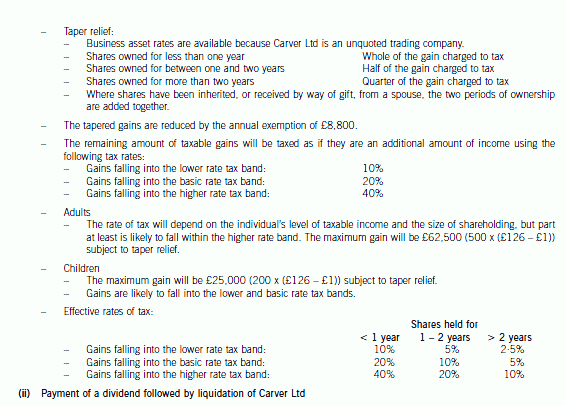
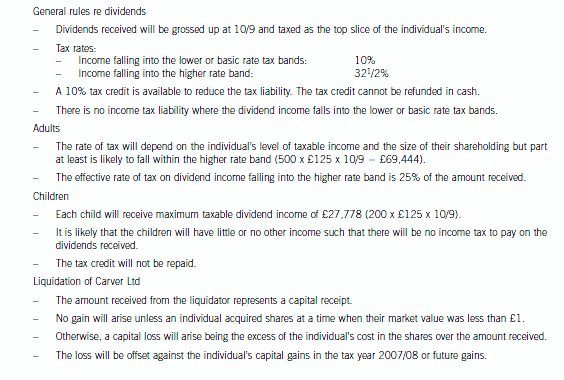
-
第19题:
(ii) The shares held in Date Inc and the dividend income received from that company. (7 marks)
正确答案:
(ii) Shares held in Date Inc and the related dividend income
Degrouping charge
There will be a degrouping charge in Nikau Ltd in the year ending 31 March 2008 in respect of the shares in Date Inc.
This is because Nikau Ltd has left the Facet Group within six years of the no gain, no loss transfer of the shares whilst
still owning them.
Nikau Ltd is treated as if it has sold the shares in Date Inc for their market value as at the time of the no gain, no loss
transfer. This will give rise to a gain, ignoring indexation allowance, of £201,000 (£338,000 – £137,000).
This gain will give rise to additional corporation tax of £60,300 (£201,000 x 30%).
Controlled foreign company
Date Inc is a controlled foreign company. The profits of such a company are normally attributed to its UK resident
shareholders such that they are subject to UK corporation tax.
However, none of the profits of Date Inc will be attributed to Nikau Ltd because Date Inc distributes more than 90%
(£115,000/£120,000 = 95·8%) of its chargeable profits to its shareholders.
Dividend income
Nikau Ltd is a UK resident company and is therefore subject to corporation tax on its worldwide income.
The dividend income will be grossed up in respect of the withholding tax giving rise to taxable income of £39,792
(£38,200 x 100/96). There is no underlying tax as there are no taxes on income or capital profits in Palladia.
The corporation tax of £11,938 (£39,792 x 30%) will be reduced by unilateral double tax relief equal to the withholding
tax suffered of £1,592 (£39,792 x 4%) resulting in corporation tax due of £10,346 (£11,938 – £1,592). -
第20题:
5 Gagarin wishes to persuade a number of wealthy individuals who are business contacts to invest in his company,
Vostok Ltd. He also requires advice on the recoverability of input tax relating to the purchase of new premises.
The following information has been obtained from a meeting with Gagarin.
Vostok Ltd:
– An unquoted UK resident company.
– Gagarin owns 100% of the company’s ordinary share capital.
– Has 18 employees.
– Provides computer based services to commercial companies.
– Requires additional funds to finance its expansion.
Funds required by Vostok Ltd:
– Vostok Ltd needs to raise £420,000.
– Vostok Ltd will issue 20,000 shares at £21 per share on 31 August 2008.
– The new shareholder(s) will own 40% of the company.
– Part of the money raised will contribute towards the purchase of new premises for use by Vostok Ltd.
Gagarin’s initial thoughts:
– The minimum investment will be 5,000 shares and payment will be made in full on subscription.
– Gagarin has a number of wealthy business contacts who may be interested in investing.
– Gagarin has heard that it may be possible to obtain tax relief for up to 60% of the investment via the enterprise
investment scheme.
Wealthy business contacts:
– Are all UK resident higher rate taxpayers.
– May wish to borrow the funds to invest in Vostok Ltd if there is a tax incentive to do so.
New premises:
– Will cost £446,500 including value added tax (VAT).
– Will be used in connection with all aspects of Vostok Ltd’s business.
– Will be sold for £600,000 plus VAT in six years time.
– Vostok Ltd will waive the VAT exemption on the sale of the building.
The VAT position of Vostok Ltd:
– In the year ending 31 March 2009, 28% of Vostok Ltd’s supplies will be exempt for the purposes of VAT.
– This percentage is expected to reduce over the next few years.
– Irrecoverable input tax due to the company’s partially exempt status exceeds the de minimis limits.
Required:
(a) Prepare notes for Gagarin to use when speaking to potential investors. The notes should include:
(i) The tax incentives immediately available in respect of the amount invested in shares issued in
accordance with the enterprise investment scheme; (5 marks)
正确答案:
(a) (i) The tax incentives immediately available
Income tax
– The investor’s income tax liability for 2008/09 will be reduced by 20% of the amount subscribed for the shares.
– Up to half of the amount invested can be treated as if paid in 2007/08 rather than 2008/09. This is subject to a
maximum carryback of £50,000.
This ability to carryback relief to the previous year is useful where the investor’s income in 2008/09 is insufficient
to absorb all of the relief available.
Tutorial note
There would be no change to the income tax liability of 2007/08 where an amount is treated as if paid in that year.
This ensures that such a claim does not affect payments on account under the self assessment system. Instead, the
tax refund due is calculated by reference to 2007/08 but is deducted from the next payment of tax due from the
taxpayer or is repaid to the taxpayer.
Capital gains tax deferral
– For every £1 invested in Vostok Ltd, an investor can defer £1 of capital gain and thus, potentially, 40 pence of
capital gains tax.
– The gain deferred can be in respect of the disposal of any asset.
– The shares must be subscribed for within the four year period starting one year prior to the date on which the
disposal giving rise to the gain took place. -
第21题:
ORGANIZING A BUSINESS IN DIFFERENT WAYS Businesses are structured in different ways to meet different needs. The simplest form. of business is called an individual or sole proprietorship. The proprietor owns all of the property of the business and is responsible for everything. Another kind of business is a partnership. Two or more people go into business together. An agreement is usually needed to decide how much of the partnership each person controls. One kind of partnership is called a limited liability partnership. These have full partners and limited partners. Limited partners may not share as much in the profits, but they also have less responsibility for the business. Doctors, lawyers and accountants often form. partnerships to share their risks and profits. A husband and wife can form. a business partnership together. Partnerships exist only for as long as the owners remain alive. The same is true of individual proprietorships. But corporations are designed to have an unlimited lifetime. A corporation is the most complex kind of business organization. Corporations can sell stock as a way to raise money. Stocks represent shares of ownership in a company. Investors who buy stock can trade their shares or keep them as long as the company is in business. A corporation is recognized as an entity-its own legal being, separate from its owners. A board of directors controls corporate policies. The directors appoint top company officers. The directors might or might not hold shares in the corporation. Corporations can have a few major shareholders, or ownership can be spread among the general public. But not all corporations are traditional businesses that sell stock. Some non-profit groups are also organized as corporations.
1. This passage is mainly about ().
A. why different forms of business run
B. when different forms of business raise money
C. how different forms of business are organized
2. What is usually needed to decide the portion of the partnership each person controls?()
A. A rule.
B. An agreement.
C. A regulation.
3. Who are not included in limited liability partnerships?()
A. Full partners.
B. Limited partners.
C. Unlimited partners.
4. How can corporations raise money?()
A. By selling stock.
B. By buying stock.
C. By holding corporation shares.
5. Who controls corporate policies in a corporation?()
A. Chairman of the board.
B. A board of directors.
C. The owner of the corporation.
参考答案:1:C; 2:B;3:C; 4:A;5:B
-
第22题:
听力原文:The owners of limited companies are people who have bought shares in the company.
(6)
A.The shareholders are the owners of limited companies.
B.Shareholders deposit their money in the limited companies.
C.The shareholders can sell shares of limited companies to the public.
D.Shareholders of limited companies are able to make profits continuously.
正确答案:A
解析:单句意思为“有限公司的拥有者是那些购买公司股份的人”。 -
第23题:
问答题Practice 3 Equity securities are known as shares (or stock) in a corporation. Stockholders are considered owners of the corporation. The Articles of Incorporation must state the number of shares and the characteristics of the stock. To issue stock is actually to offer shares of stock for sale. The corporation’s Board of Directors controls when and to whom the corporation’s shares are offered and sold. Outstanding shares—Outstanding shares are shares already issued and purchased by the shareholder or stockholder. Par value—Par value is an arbitrary value assigned to each share in the Articles of Incorporation but does not necessarily reflect the true market value of the stock. Shares may not be issued and sold by the corporation for less than their par value therefore it is sometimes advisable not to state any par value at all or state a par value lower than the estimated market price. No par value allows the Board of Directors to decide each time shares are issued what the price per share will be. In a very large corporation where the stock is publicly traded at a public exchange, such as the New York Stock Exchange, the public demand for the stock of the corporation rather than the Board of Directors determines the selling price of the stock. Capital account—The capital account of a corporation is an entry in the books of the corporation and is determined by multiplying the par or stated value of the corporation’s stock by the number of shares outstanding. For example, if the corporation had sold 1,000 shares of stock which had $10 par value, the capital account would be $10,000.正确答案:
【参考译文】
股票是指公司发行的股份。股东是公司的所有者。公司条例必须说明公司股份的数量及其特征。发行股票实际上是出售公司的股份。公司董事会决定何时以及向何种人发售股票。
流动股——指已发行的,股东已购买的股票。
票面价值——指根据公司条例而赋予每股股票的价值。但它并不一定反映股票真正的市场价值。股票不能以低于票面价值发行和出售,因此有时不规定票面价值或所规定的票面价值低于估计的市场价值是非常明智的。在没有规定票面价值时,公司董事会得以在每次发行股票时决定每股的价格。某大公司的股票在大型公共交易所(如纽约证券交易所)进行公开交易时,公众对公司股票的需求而不是公司董事会决定该公司股票的交易价格。
资本性账户——指公司登记在册的资本,它等于流动股的数量与票面价值或是规定价值的乘积。比如说,某公司发行了1000股,每股票面价值为10美元,它的资本账户则是1万美元。解析: 暂无解析
